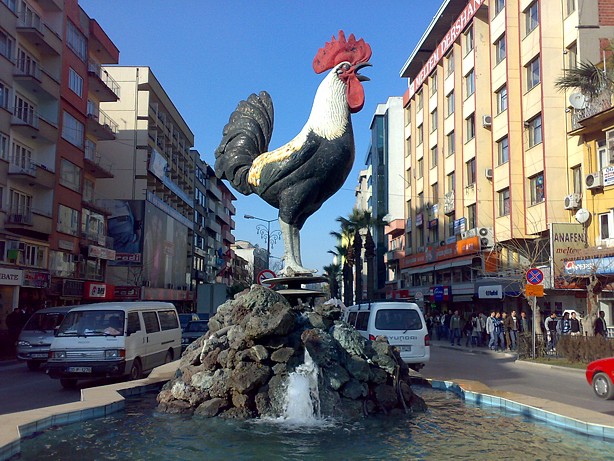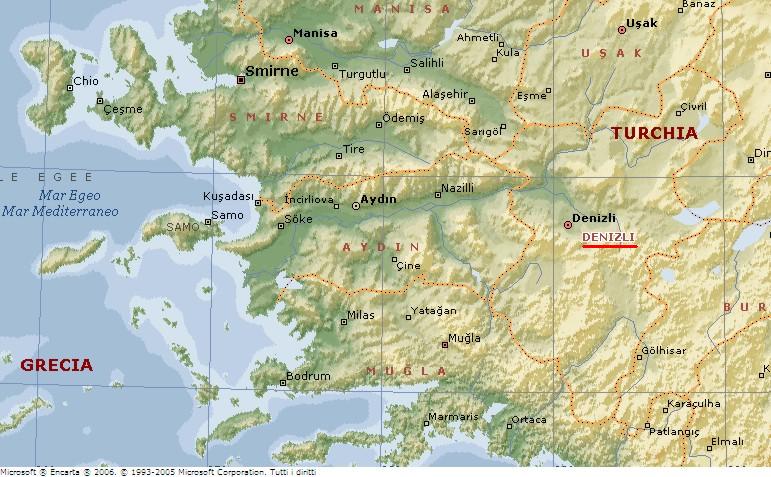Denizli
Denizli is a growing industrial city in the eastern end of the alluvial valley formed by the river Büyük Menderes, where the plain reaches an elevation of about a hundred meters, in southwestern Turkey, in the country's Aegean Region. The city has a population of about 483,000 (2008 census) and is the capital city of Denizli Province. Denizli has achieved a remarkable economic development in the last decades based notably on textile production and exports. Having become a vibrant center of manufacturing focused on exportation, Denizli is frequently cited, along with a number of other Turkish cities, as one of the foremost examples of "Anatolian Tigers" in reference to its rapid pace of development.

Denizli cockerel - Denizli horozu
Denizli is renowned in Turkey for having a famous breed of cock, renowned for its appearance and colour, along with its prolonged and melodious crows. Great effort is taken by the state and local farmers to preserve the breed. In appearance the Denizli cock has black eyes, dark grey legs, a long neck, and a red crown. It weighs 3-3.5kg, and has a distinctive crow.
Denizli also attracts many visitors to the nearby mineral-coated hillside hot spring of Pamukkale, and the ancient ruined city of Hierapolis, as well as ruins of the city of Laodicea on the Lycus, the ancient metropolis of Phrygia. Also in the depending of Honaz, about 10 miles west of Denizli is, what was, in the 1st century AD, the city of Colossae. The weather is very hot in Denizli in summers, whereas in winters, it may occasionally be very cold with snow on the mountains that surround the city. Springs and autumns are generally rainy.

The city was formerly known as Denizli Ladik, that is, "Laodicaea on the sea/lake", but the town is not on the coast. The name mutated through several spellings and may have referred to the abundance of underground water sources or the city's location on the way to western Turkey's lakes region nearby. An alternative theory holds that the name was Domuzlu (the place of boars) due to the boar in the mountains around the town, and was changed as Muslims found the name offensive. The area has been occupied since prehistoric times, there were important ancient Greek and Roman towns nearby, (Hierapolis and Laodicea on the Lycus), which persisted through the Byzantine period.
The city was founded in its current location after the area has been settled by the Turks. The inhabitants of Laodicea were resettled here in the Seljuk period. In the 17th century, the Turkish traveler Evliya Çelebi visited Denizli and recorded the town as follows: "The city is called (Denizli) (which means seaside in Turkish) as there are several rivers and lakes around it. In fact it is a four day trip from the sea. Its fortress is of square shape built on flat ground. It has no ditches. Its periphery is 470 steps long. It has four gates. These are: painters gate in North, saddle-makers gate in the East, new Mosque gate in the South, and vineyard gate in the West. There are some fifty armed watchmen in the fortress, and they attend the shop. The main city is outside the fortress with 44 districts and 3600 houses. There are 57 small and large mosques and district masjids, 7 madrasahs, 7 children's schools, 6 baths and 17 dervish lodges. As everybody lives in vineyards the upper classes and ordinary people do not flee from each other."
The city lived in peace for centuries without being involved in wars in a direct manner. Following the World War I during the Independence War the Greek forces managed to come as close as Sarayköy, a small town 20 km (12 mi) northwest of Denizli, but did not venture into Denizli where resistance was being prepared.
Denizli Province
Denizli is a province of Turkey in Western Anatolia, on high ground above the Aegean coast. Neighbouring provinces are Uşak to the north, Burdur, Isparta, Afyon to the east, Aydın, Manisa to the west and Muğla to the south. It is located between the coordinates 28° 30 and 29° 30 E and 37° 12 and 38° 12 N. It covers an area of 11,868 km², and the population is 882,938. The population was 750,882 in 1990. The provincial capital is the city of Denizli. Denizli province is divided into 19 districts.
Approximately 28-30% of the land is plain, 25% is high plateau and tableland, and 47% is mountainous. At 2571m Mount Honaz is the highest in the province, and indeed in Western Anatolia. Babadag in the Mentes range has a height of 2308 meters. The biggest lake in Denizli is Acıgöl, which means bitter lake and indeed industrial salts (sodium sulphate) are extracted from this lake which is highly alkaline. There is a thermal spring to the west of Sarayköy, at the source of the Great Menderes River, which contains bicarbonates and sulfates. There is another hot spring in Kizildere which reaches 200˚C.
A geothermal steam source was first found in the region in 1965 during drilling work. Today there is a power plant producing electricity from the geothermal steam. Only 11% of the geothermal energy source is used to produce electricity and 89% of it, which flows into the Great Menderes, is 150˚C at source (it is contains energy equal to 35,000 to 40,000 tonnes of fuel oil). In general the Aegean region has a mild climate. However, it becomes harsher at altitude . Temperatures can rise to 40 °C during summer and fall to -10 °C in winter. There are about 80 days with precipitation, mainly during winter.
There are traces of prehistoric cultures throughout the province, including evidence of pre-Hittite cultures and the Hittites themselves. The Hittites were followed by Phrygians, Lydians and Persians, and then cities founded by the ancient Greeks and Alexander the Great. The first real settlement was the city of Laodicea on the Lycus which was established by King Antiochus II for his wife Laodice. Laodicea is located 6 km north of the city of Denizli. The city of Hierapolis was established around 190 BC by the Pergamene Kingdom, one of the Hellenistic states of Anatolia. The calcified terraces and pools of Pamukkale (Cotton Castle) now stand below the ruins of Hierapolis. The two cities, Laodicea and Hierapolis later came under Roman rule, and with the division of the Empire in 395 were left within the boundaries of the East Roman Empire.
The province has strong biblical connections: in the Book of Revelation, John the Evangelist hears a loud voice which sounded like a trumpet when he was on the island of Patmos. The voice says: "Write down what you see and send the book to the Churches in these seven cities: Ephesus, Smyrna, Pergamum, Thyatira, Sardis, Philadelphia and Laodicea". The Church of Laodicea was a sacred place even in pre-Christian times, and is still visited by Christians today, although it lost its importance to a great extent during Byzantine rule.
Turks were first seen in Denizli in 1070 when Afşın Bey, under the control of the Seljuk Sultan Alp Arslan, raided the area. The second and third Crusades fought here against Kazıkbeli, who managed to flee with a small force to Antalya. Later, after the Turks had established control of the ancient cities, they moved south to the site of the present city of Denizli, where drinking water was brought through stone pipes. The name Laodicea slowly changed into Ladik then since the 17th century other names were given Tonguzlu, Tonuzlu, Tenguzlug, Donuzlu and finally Denizli.
After World War I, when the Greek army arrived in İzmir on May 15, 1919, one of first centres of Turkish resistance formed at an open air meeting in Denizli. A Turkish militia formed lines on the Menderes organized by Yörük Ali and Demirci Efe, involving large numbers of volunteers from the local peasantry. Stiffened by the Turkish regular army, Greek forces were repelled, and Denizli remained in Turkish hands throughout the Greco-Turkish War.
